Analysis of Enterprise Data Model for a Paediatric Medical Centre
VerifiedAdded on 2021/01/02
|9
|2669
|313
Report
AI Summary
This report provides an in-depth analysis of an Enterprise Data Model (EDM) tailored for a Paediatric Medical Centre (PMC). It begins with an introduction to EDMs and their importance in managing data across an organization, particularly in healthcare settings. The main body of the report explores the requirements of the PMC, including the need for a new medical information system, and discusses various EDM approaches such as Subject Area Models, Conceptual Data Models, and Enterprise Logical Data Models, including the Centre Out approach. The report examines how the DAMA DMBOK textbook's principles of "Understanding enterprise information needs" and "Develop and Maintain the Enterprise Data Model" apply to the PMC. It also delves into the unique aspects of the paediatric healthcare industry, including government regulations, business concerns, and the importance of data security and patient privacy. The report concludes by emphasizing the significance of protecting patient data and the role of EDM in enhancing data management, ensuring data accuracy, and supporting secure healthcare practices. The report highlights the critical aspects for the PMC, including document architecture, user interfaces, and patient data linkage within the context of the healthcare industry.
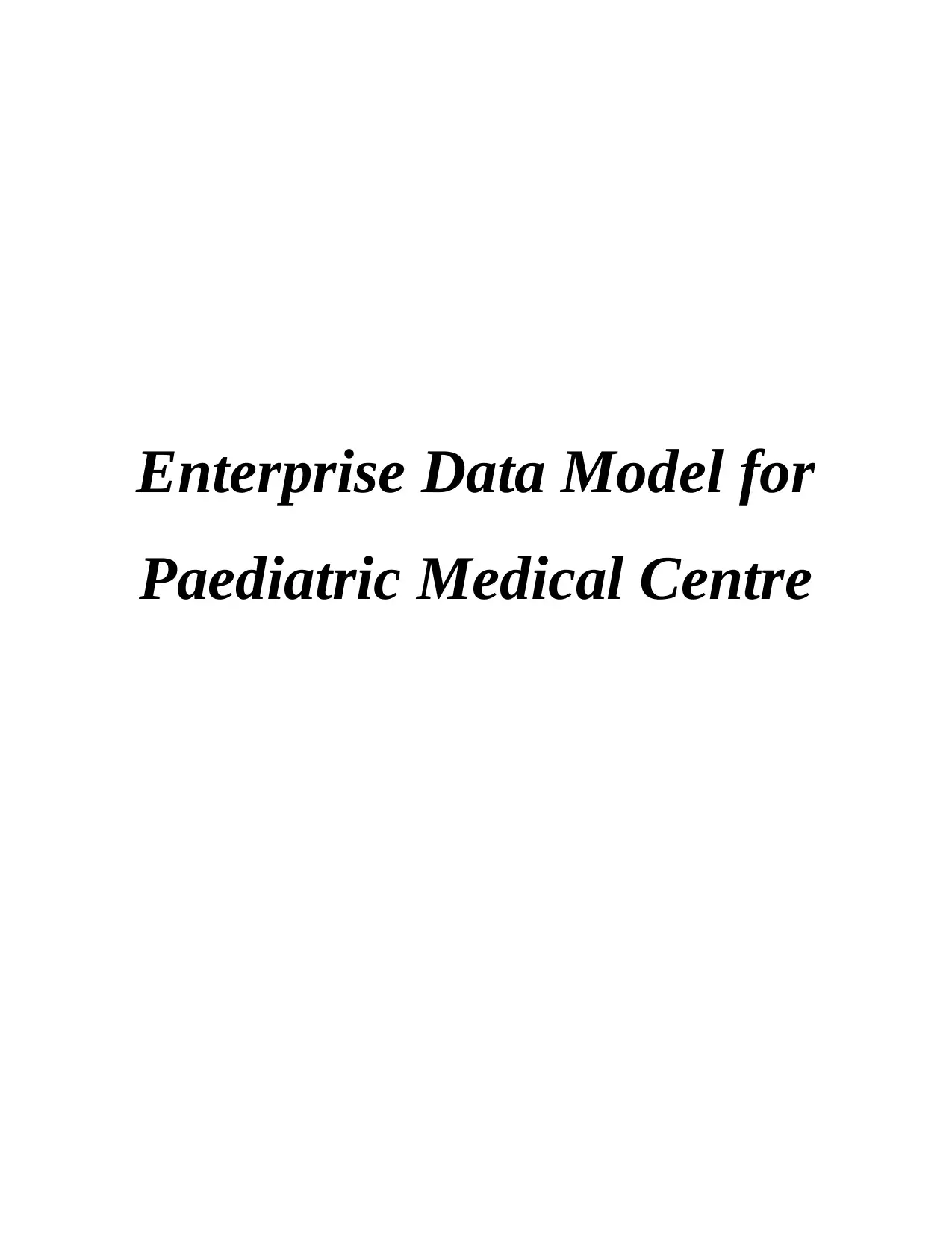
Enterprise Data Model for
Paediatric Medical Centre
Paediatric Medical Centre
Paraphrase This Document
Need a fresh take? Get an instant paraphrase of this document with our AI Paraphraser
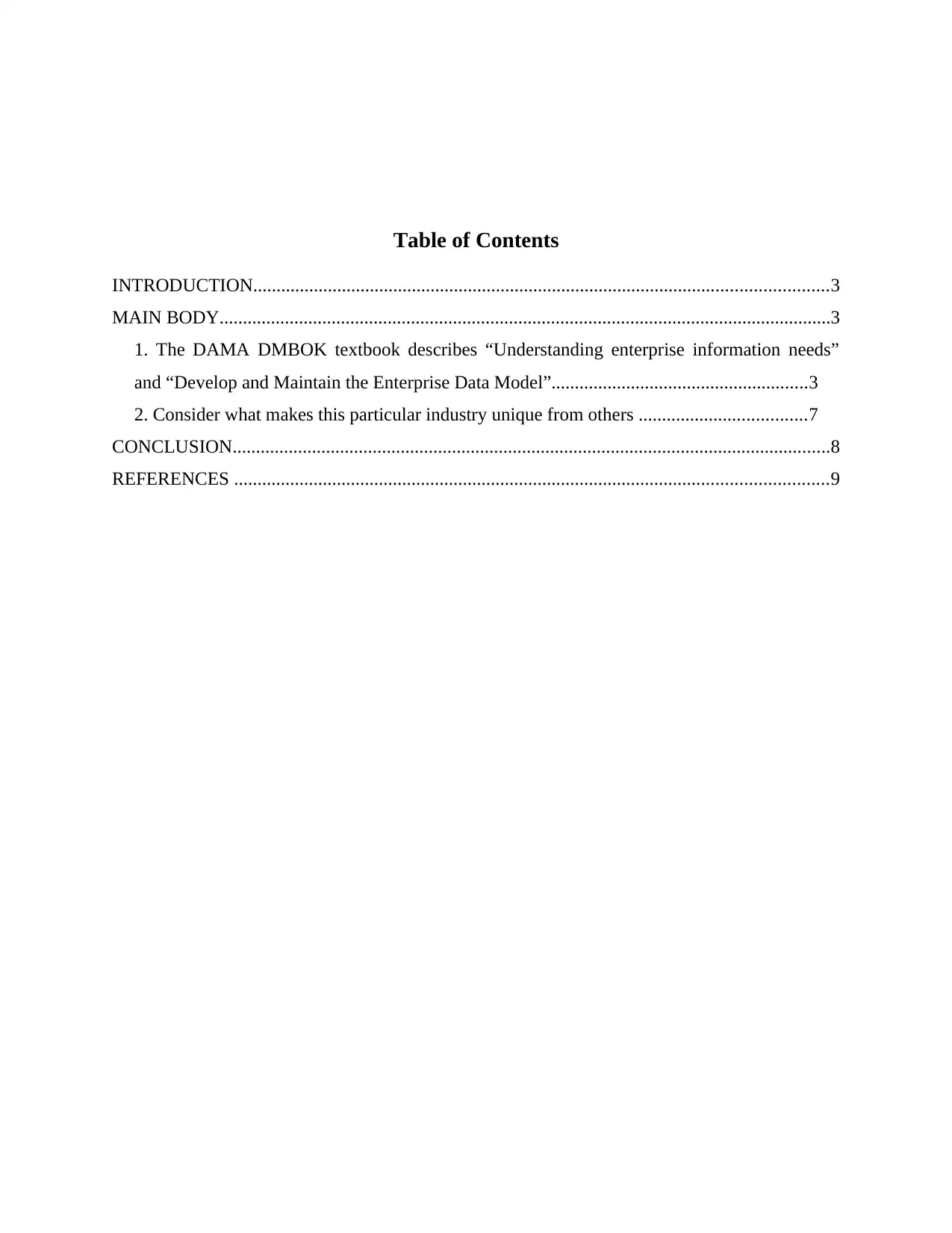
Table of Contents
INTRODUCTION...........................................................................................................................3
MAIN BODY...................................................................................................................................3
1. The DAMA DMBOK textbook describes “Understanding enterprise information needs”
and “Develop and Maintain the Enterprise Data Model”.......................................................3
2. Consider what makes this particular industry unique from others ....................................7
CONCLUSION................................................................................................................................8
REFERENCES ...............................................................................................................................9
INTRODUCTION...........................................................................................................................3
MAIN BODY...................................................................................................................................3
1. The DAMA DMBOK textbook describes “Understanding enterprise information needs”
and “Develop and Maintain the Enterprise Data Model”.......................................................3
2. Consider what makes this particular industry unique from others ....................................7
CONCLUSION................................................................................................................................8
REFERENCES ...............................................................................................................................9
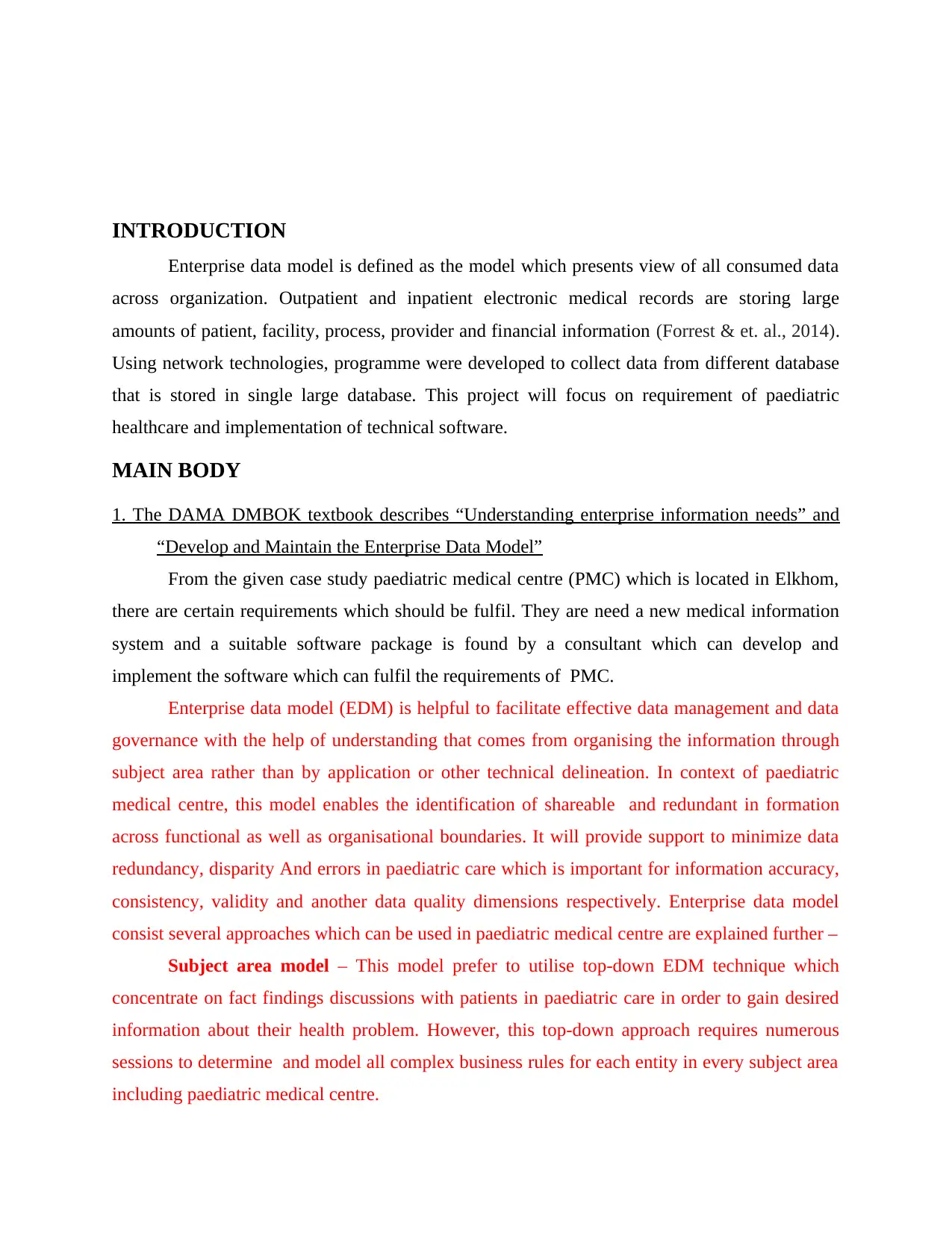
INTRODUCTION
Enterprise data model is defined as the model which presents view of all consumed data
across organization. Outpatient and inpatient electronic medical records are storing large
amounts of patient, facility, process, provider and financial information (Forrest & et. al., 2014).
Using network technologies, programme were developed to collect data from different database
that is stored in single large database. This project will focus on requirement of paediatric
healthcare and implementation of technical software.
MAIN BODY
1. The DAMA DMBOK textbook describes “Understanding enterprise information needs” and
“Develop and Maintain the Enterprise Data Model”
From the given case study paediatric medical centre (PMC) which is located in Elkhom,
there are certain requirements which should be fulfil. They are need a new medical information
system and a suitable software package is found by a consultant which can develop and
implement the software which can fulfil the requirements of PMC.
Enterprise data model (EDM) is helpful to facilitate effective data management and data
governance with the help of understanding that comes from organising the information through
subject area rather than by application or other technical delineation. In context of paediatric
medical centre, this model enables the identification of shareable and redundant in formation
across functional as well as organisational boundaries. It will provide support to minimize data
redundancy, disparity And errors in paediatric care which is important for information accuracy,
consistency, validity and another data quality dimensions respectively. Enterprise data model
consist several approaches which can be used in paediatric medical centre are explained further –
Subject area model – This model prefer to utilise top-down EDM technique which
concentrate on fact findings discussions with patients in paediatric care in order to gain desired
information about their health problem. However, this top-down approach requires numerous
sessions to determine and model all complex business rules for each entity in every subject area
including paediatric medical centre.
Enterprise data model is defined as the model which presents view of all consumed data
across organization. Outpatient and inpatient electronic medical records are storing large
amounts of patient, facility, process, provider and financial information (Forrest & et. al., 2014).
Using network technologies, programme were developed to collect data from different database
that is stored in single large database. This project will focus on requirement of paediatric
healthcare and implementation of technical software.
MAIN BODY
1. The DAMA DMBOK textbook describes “Understanding enterprise information needs” and
“Develop and Maintain the Enterprise Data Model”
From the given case study paediatric medical centre (PMC) which is located in Elkhom,
there are certain requirements which should be fulfil. They are need a new medical information
system and a suitable software package is found by a consultant which can develop and
implement the software which can fulfil the requirements of PMC.
Enterprise data model (EDM) is helpful to facilitate effective data management and data
governance with the help of understanding that comes from organising the information through
subject area rather than by application or other technical delineation. In context of paediatric
medical centre, this model enables the identification of shareable and redundant in formation
across functional as well as organisational boundaries. It will provide support to minimize data
redundancy, disparity And errors in paediatric care which is important for information accuracy,
consistency, validity and another data quality dimensions respectively. Enterprise data model
consist several approaches which can be used in paediatric medical centre are explained further –
Subject area model – This model prefer to utilise top-down EDM technique which
concentrate on fact findings discussions with patients in paediatric care in order to gain desired
information about their health problem. However, this top-down approach requires numerous
sessions to determine and model all complex business rules for each entity in every subject area
including paediatric medical centre.
⊘ This is a preview!⊘
Do you want full access?
Subscribe today to unlock all pages.

Trusted by 1+ million students worldwide
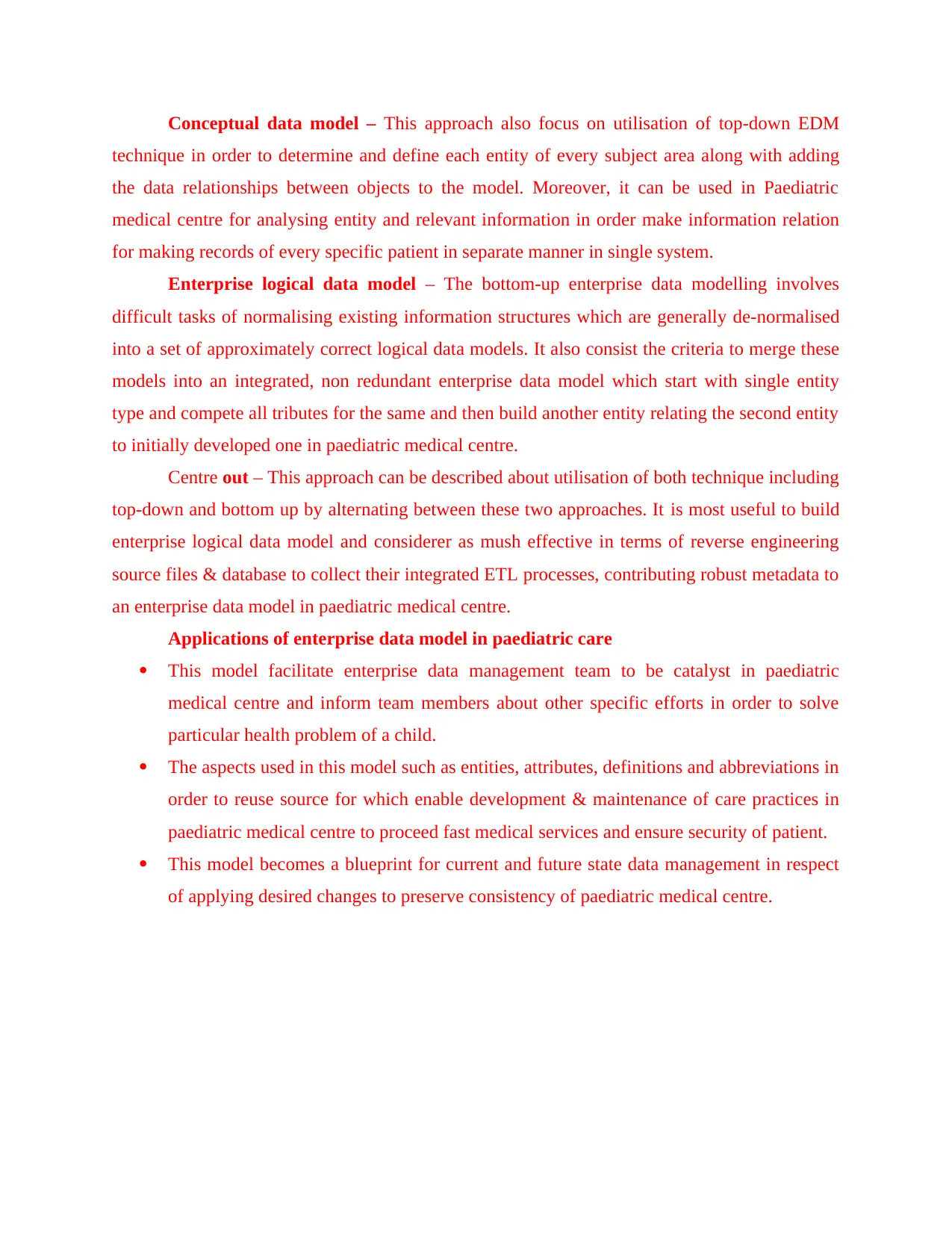
Conceptual data model – This approach also focus on utilisation of top-down EDM
technique in order to determine and define each entity of every subject area along with adding
the data relationships between objects to the model. Moreover, it can be used in Paediatric
medical centre for analysing entity and relevant information in order make information relation
for making records of every specific patient in separate manner in single system.
Enterprise logical data model – The bottom-up enterprise data modelling involves
difficult tasks of normalising existing information structures which are generally de-normalised
into a set of approximately correct logical data models. It also consist the criteria to merge these
models into an integrated, non redundant enterprise data model which start with single entity
type and compete all tributes for the same and then build another entity relating the second entity
to initially developed one in paediatric medical centre.
Centre out – This approach can be described about utilisation of both technique including
top-down and bottom up by alternating between these two approaches. It is most useful to build
enterprise logical data model and considerer as mush effective in terms of reverse engineering
source files & database to collect their integrated ETL processes, contributing robust metadata to
an enterprise data model in paediatric medical centre.
Applications of enterprise data model in paediatric care
This model facilitate enterprise data management team to be catalyst in paediatric
medical centre and inform team members about other specific efforts in order to solve
particular health problem of a child.
The aspects used in this model such as entities, attributes, definitions and abbreviations in
order to reuse source for which enable development & maintenance of care practices in
paediatric medical centre to proceed fast medical services and ensure security of patient.
This model becomes a blueprint for current and future state data management in respect
of applying desired changes to preserve consistency of paediatric medical centre.
technique in order to determine and define each entity of every subject area along with adding
the data relationships between objects to the model. Moreover, it can be used in Paediatric
medical centre for analysing entity and relevant information in order make information relation
for making records of every specific patient in separate manner in single system.
Enterprise logical data model – The bottom-up enterprise data modelling involves
difficult tasks of normalising existing information structures which are generally de-normalised
into a set of approximately correct logical data models. It also consist the criteria to merge these
models into an integrated, non redundant enterprise data model which start with single entity
type and compete all tributes for the same and then build another entity relating the second entity
to initially developed one in paediatric medical centre.
Centre out – This approach can be described about utilisation of both technique including
top-down and bottom up by alternating between these two approaches. It is most useful to build
enterprise logical data model and considerer as mush effective in terms of reverse engineering
source files & database to collect their integrated ETL processes, contributing robust metadata to
an enterprise data model in paediatric medical centre.
Applications of enterprise data model in paediatric care
This model facilitate enterprise data management team to be catalyst in paediatric
medical centre and inform team members about other specific efforts in order to solve
particular health problem of a child.
The aspects used in this model such as entities, attributes, definitions and abbreviations in
order to reuse source for which enable development & maintenance of care practices in
paediatric medical centre to proceed fast medical services and ensure security of patient.
This model becomes a blueprint for current and future state data management in respect
of applying desired changes to preserve consistency of paediatric medical centre.
Paraphrase This Document
Need a fresh take? Get an instant paraphrase of this document with our AI Paraphraser
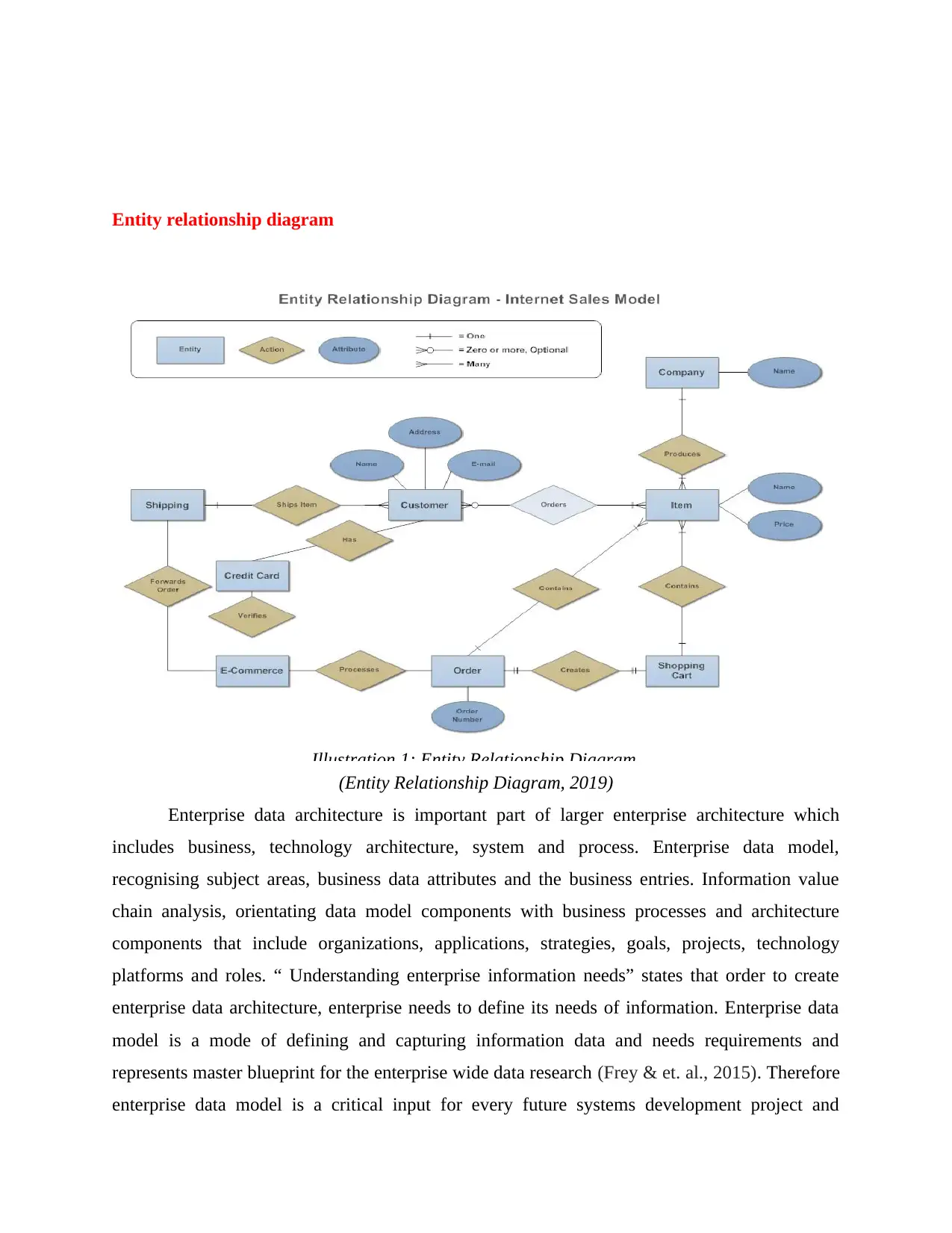
Entity relationship diagram
(Entity Relationship Diagram, 2019)
Enterprise data architecture is important part of larger enterprise architecture which
includes business, technology architecture, system and process. Enterprise data model,
recognising subject areas, business data attributes and the business entries. Information value
chain analysis, orientating data model components with business processes and architecture
components that include organizations, applications, strategies, goals, projects, technology
platforms and roles. “ Understanding enterprise information needs” states that order to create
enterprise data architecture, enterprise needs to define its needs of information. Enterprise data
model is a mode of defining and capturing information data and needs requirements and
represents master blueprint for the enterprise wide data research (Frey & et. al., 2015). Therefore
enterprise data model is a critical input for every future systems development project and
Illustration 1: Entity Relationship Diagram
(Entity Relationship Diagram, 2019)
Enterprise data architecture is important part of larger enterprise architecture which
includes business, technology architecture, system and process. Enterprise data model,
recognising subject areas, business data attributes and the business entries. Information value
chain analysis, orientating data model components with business processes and architecture
components that include organizations, applications, strategies, goals, projects, technology
platforms and roles. “ Understanding enterprise information needs” states that order to create
enterprise data architecture, enterprise needs to define its needs of information. Enterprise data
model is a mode of defining and capturing information data and needs requirements and
represents master blueprint for the enterprise wide data research (Frey & et. al., 2015). Therefore
enterprise data model is a critical input for every future systems development project and
Illustration 1: Entity Relationship Diagram

baseline for extra data requirements investigation and data modelling activity undertaken at
project level.
Logical data and project conceptual models are supported on applicable portions of
enterprise data model. Some projects will profit more from enterprise data model compare to
others will, which will depend on project scope. Every essential project will profit from, and
impact, enterprise data model. There is a way of determining information needs of enterprise to
check current outputs and inputs required by organization from both external and internal targets.
Use actual system reports and documentation, and interview participants. And this material
provides list of required and important data attributes, calculation and data entries. These item
has to organize by subject area and business unit. List review with participants to assure proper
completeness and categorization. And then this list becomes basic requirements for enterprise
data model. PMC need some software and devices which can store information about patient and
there are certain requirement for the software such as it should be able to track parents whose
children are with paediatric and it has to store information of patients.
Document architecture: It is a method for indicating electronically clinical data like
discharge progress or summaries notes and patient's safety reports needed standardized document
architecture (Nkoy & et. al., 2015). Needed stems from desire to access considerable content
present stock in a free text clinical notes and alter comparison of the content from created
documents on information system which are broadly varying characteristics.
User interface: Medical device industry, which is well experient in developing interfaces
of user which make devices safer, easier to use and more effective for users.
Patient data linkage: In this patient's healthcare data can be located from one
departmental location to another which is important for maintaining integrity of patient
delivering safe care and data.
The other statement from DAMA DMBOK textbook is “ Development and maintain the
enterprise data model” which is explained as business entries are the classes of real business
concepts and things. Data is set of facts which is collected about business entries. This data
model defines business entries and kinds of facts such as data attributes are needed about
business entries to guide and operate business (Danciu & et. al., 2014). Data modelling is a
design and analysis method used to analyse and define data requirements and design physical
and logical data structure s which support those requirements.
project level.
Logical data and project conceptual models are supported on applicable portions of
enterprise data model. Some projects will profit more from enterprise data model compare to
others will, which will depend on project scope. Every essential project will profit from, and
impact, enterprise data model. There is a way of determining information needs of enterprise to
check current outputs and inputs required by organization from both external and internal targets.
Use actual system reports and documentation, and interview participants. And this material
provides list of required and important data attributes, calculation and data entries. These item
has to organize by subject area and business unit. List review with participants to assure proper
completeness and categorization. And then this list becomes basic requirements for enterprise
data model. PMC need some software and devices which can store information about patient and
there are certain requirement for the software such as it should be able to track parents whose
children are with paediatric and it has to store information of patients.
Document architecture: It is a method for indicating electronically clinical data like
discharge progress or summaries notes and patient's safety reports needed standardized document
architecture (Nkoy & et. al., 2015). Needed stems from desire to access considerable content
present stock in a free text clinical notes and alter comparison of the content from created
documents on information system which are broadly varying characteristics.
User interface: Medical device industry, which is well experient in developing interfaces
of user which make devices safer, easier to use and more effective for users.
Patient data linkage: In this patient's healthcare data can be located from one
departmental location to another which is important for maintaining integrity of patient
delivering safe care and data.
The other statement from DAMA DMBOK textbook is “ Development and maintain the
enterprise data model” which is explained as business entries are the classes of real business
concepts and things. Data is set of facts which is collected about business entries. This data
model defines business entries and kinds of facts such as data attributes are needed about
business entries to guide and operate business (Danciu & et. al., 2014). Data modelling is a
design and analysis method used to analyse and define data requirements and design physical
and logical data structure s which support those requirements.
⊘ This is a preview!⊘
Do you want full access?
Subscribe today to unlock all pages.

Trusted by 1+ million students worldwide

This model helps to provide higher quality as architects consider blueprint which is made
before construction of a building just like that data should be considered before building any app.
Sometimes software development efforts fail. Application can be build at lower cost via models
of data. The software which is built should be released in market as quick as possible because it
provides application to PMC. Error should be less because it can create problems.
2. Consider what makes this particular industry unique from others
Solution of healthcare system's problems are found in more approaches that are market
based. Consumer directed health strategies are at centre of the given concept. If people make
spend more money, they will more provident users of care and want better value at low cost.
This is how industries works and people do not complain about them much. Healthcare and
airline industry and both have obstacles to entry because it requires special licenses and later it
requires considerable regulatory and capital compliance. Doctor is required to treat people who is
trusted by people with the care or treatment. Health insurance and health services are complex
and differentiated which is different from other retail industry. In PMC industry, during
treatment a person might die which is a hard thing for doctors. And it is hard for assure to resist
backlash which comes when people say no to things which makes harder for government to
refuse. It may not be important for wealthy, healthy and young people but for older, sick and
poorer people it dominates (Fleurence & et. al., 2014). It is hard to be provident care purchaser
when individual in ICU. There are certain risk in healthcare for those who are old and serious
with some condition. There are surety of security which should be provided by healthcare and
can not reveal to others. Other data related to patient and the health condition which should be
kept private. These things make healthcare industry unique from other industry.
Government regulations: The government legislation supporting 'My health record
system' which was developed with stakeholders in consultation. It plays a major role and
function in healthcare such as registration framework for people and entities like health provider
organisations who can participate in 'My health record system'. Privacy framework specifying
which entities can be collected, disclose and use particular information in system and penalties
which can be enforce on improper collection, disclosure and use of the given information
(Sanford & et. al., 2017). There are certain acts which provide data security to the individuals.
Government regulations are made to help in healthcare and protect certain data which should be
secure.
before construction of a building just like that data should be considered before building any app.
Sometimes software development efforts fail. Application can be build at lower cost via models
of data. The software which is built should be released in market as quick as possible because it
provides application to PMC. Error should be less because it can create problems.
2. Consider what makes this particular industry unique from others
Solution of healthcare system's problems are found in more approaches that are market
based. Consumer directed health strategies are at centre of the given concept. If people make
spend more money, they will more provident users of care and want better value at low cost.
This is how industries works and people do not complain about them much. Healthcare and
airline industry and both have obstacles to entry because it requires special licenses and later it
requires considerable regulatory and capital compliance. Doctor is required to treat people who is
trusted by people with the care or treatment. Health insurance and health services are complex
and differentiated which is different from other retail industry. In PMC industry, during
treatment a person might die which is a hard thing for doctors. And it is hard for assure to resist
backlash which comes when people say no to things which makes harder for government to
refuse. It may not be important for wealthy, healthy and young people but for older, sick and
poorer people it dominates (Fleurence & et. al., 2014). It is hard to be provident care purchaser
when individual in ICU. There are certain risk in healthcare for those who are old and serious
with some condition. There are surety of security which should be provided by healthcare and
can not reveal to others. Other data related to patient and the health condition which should be
kept private. These things make healthcare industry unique from other industry.
Government regulations: The government legislation supporting 'My health record
system' which was developed with stakeholders in consultation. It plays a major role and
function in healthcare such as registration framework for people and entities like health provider
organisations who can participate in 'My health record system'. Privacy framework specifying
which entities can be collected, disclose and use particular information in system and penalties
which can be enforce on improper collection, disclosure and use of the given information
(Sanford & et. al., 2017). There are certain acts which provide data security to the individuals.
Government regulations are made to help in healthcare and protect certain data which should be
secure.
Paraphrase This Document
Need a fresh take? Get an instant paraphrase of this document with our AI Paraphraser
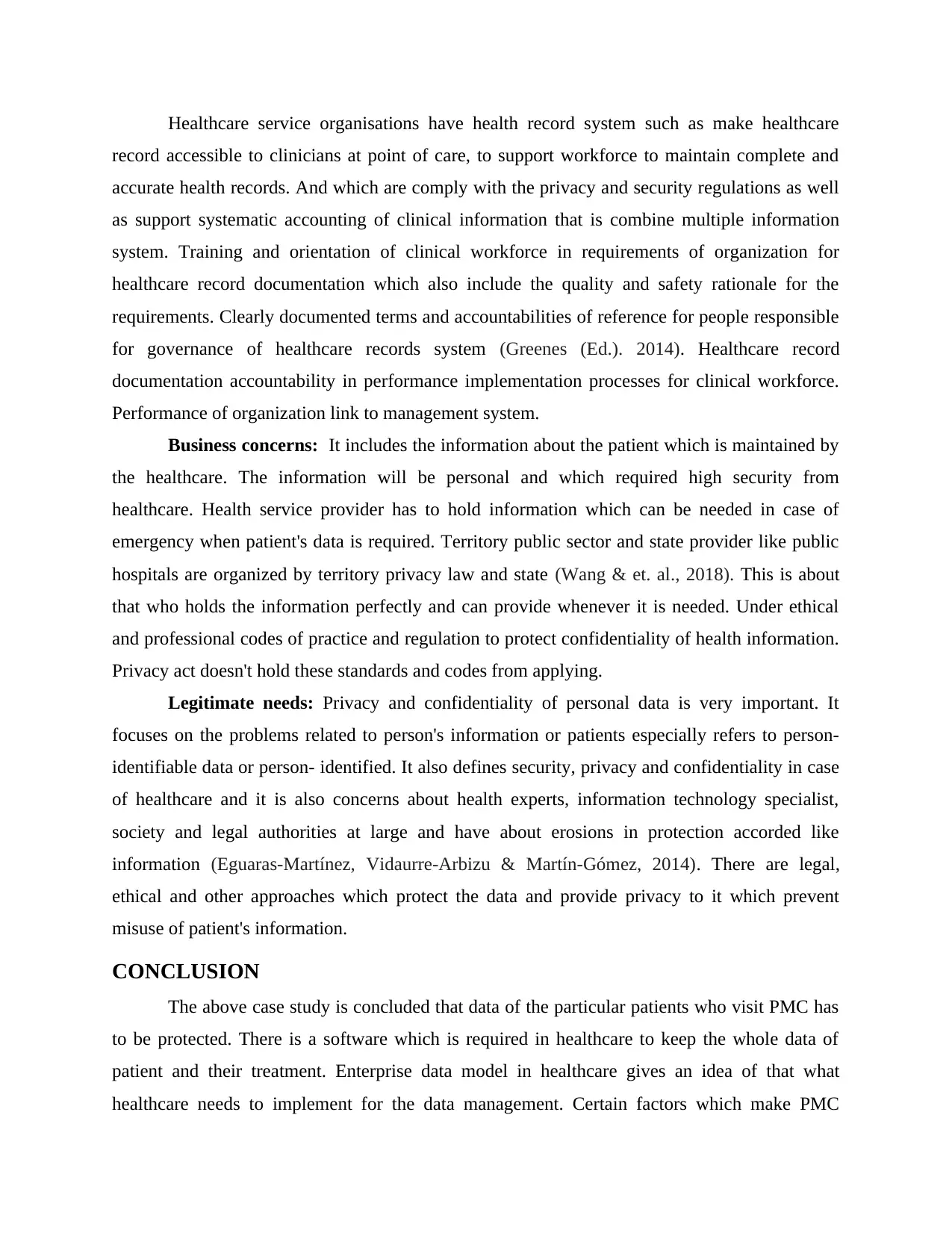
Healthcare service organisations have health record system such as make healthcare
record accessible to clinicians at point of care, to support workforce to maintain complete and
accurate health records. And which are comply with the privacy and security regulations as well
as support systematic accounting of clinical information that is combine multiple information
system. Training and orientation of clinical workforce in requirements of organization for
healthcare record documentation which also include the quality and safety rationale for the
requirements. Clearly documented terms and accountabilities of reference for people responsible
for governance of healthcare records system (Greenes (Ed.). 2014). Healthcare record
documentation accountability in performance implementation processes for clinical workforce.
Performance of organization link to management system.
Business concerns: It includes the information about the patient which is maintained by
the healthcare. The information will be personal and which required high security from
healthcare. Health service provider has to hold information which can be needed in case of
emergency when patient's data is required. Territory public sector and state provider like public
hospitals are organized by territory privacy law and state (Wang & et. al., 2018). This is about
that who holds the information perfectly and can provide whenever it is needed. Under ethical
and professional codes of practice and regulation to protect confidentiality of health information.
Privacy act doesn't hold these standards and codes from applying.
Legitimate needs: Privacy and confidentiality of personal data is very important. It
focuses on the problems related to person's information or patients especially refers to person-
identifiable data or person- identified. It also defines security, privacy and confidentiality in case
of healthcare and it is also concerns about health experts, information technology specialist,
society and legal authorities at large and have about erosions in protection accorded like
information (Eguaras-Martínez, Vidaurre-Arbizu & Martín-Gómez, 2014). There are legal,
ethical and other approaches which protect the data and provide privacy to it which prevent
misuse of patient's information.
CONCLUSION
The above case study is concluded that data of the particular patients who visit PMC has
to be protected. There is a software which is required in healthcare to keep the whole data of
patient and their treatment. Enterprise data model in healthcare gives an idea of that what
healthcare needs to implement for the data management. Certain factors which make PMC
record accessible to clinicians at point of care, to support workforce to maintain complete and
accurate health records. And which are comply with the privacy and security regulations as well
as support systematic accounting of clinical information that is combine multiple information
system. Training and orientation of clinical workforce in requirements of organization for
healthcare record documentation which also include the quality and safety rationale for the
requirements. Clearly documented terms and accountabilities of reference for people responsible
for governance of healthcare records system (Greenes (Ed.). 2014). Healthcare record
documentation accountability in performance implementation processes for clinical workforce.
Performance of organization link to management system.
Business concerns: It includes the information about the patient which is maintained by
the healthcare. The information will be personal and which required high security from
healthcare. Health service provider has to hold information which can be needed in case of
emergency when patient's data is required. Territory public sector and state provider like public
hospitals are organized by territory privacy law and state (Wang & et. al., 2018). This is about
that who holds the information perfectly and can provide whenever it is needed. Under ethical
and professional codes of practice and regulation to protect confidentiality of health information.
Privacy act doesn't hold these standards and codes from applying.
Legitimate needs: Privacy and confidentiality of personal data is very important. It
focuses on the problems related to person's information or patients especially refers to person-
identifiable data or person- identified. It also defines security, privacy and confidentiality in case
of healthcare and it is also concerns about health experts, information technology specialist,
society and legal authorities at large and have about erosions in protection accorded like
information (Eguaras-Martínez, Vidaurre-Arbizu & Martín-Gómez, 2014). There are legal,
ethical and other approaches which protect the data and provide privacy to it which prevent
misuse of patient's information.
CONCLUSION
The above case study is concluded that data of the particular patients who visit PMC has
to be protected. There is a software which is required in healthcare to keep the whole data of
patient and their treatment. Enterprise data model in healthcare gives an idea of that what
healthcare needs to implement for the data management. Certain factors which make PMC
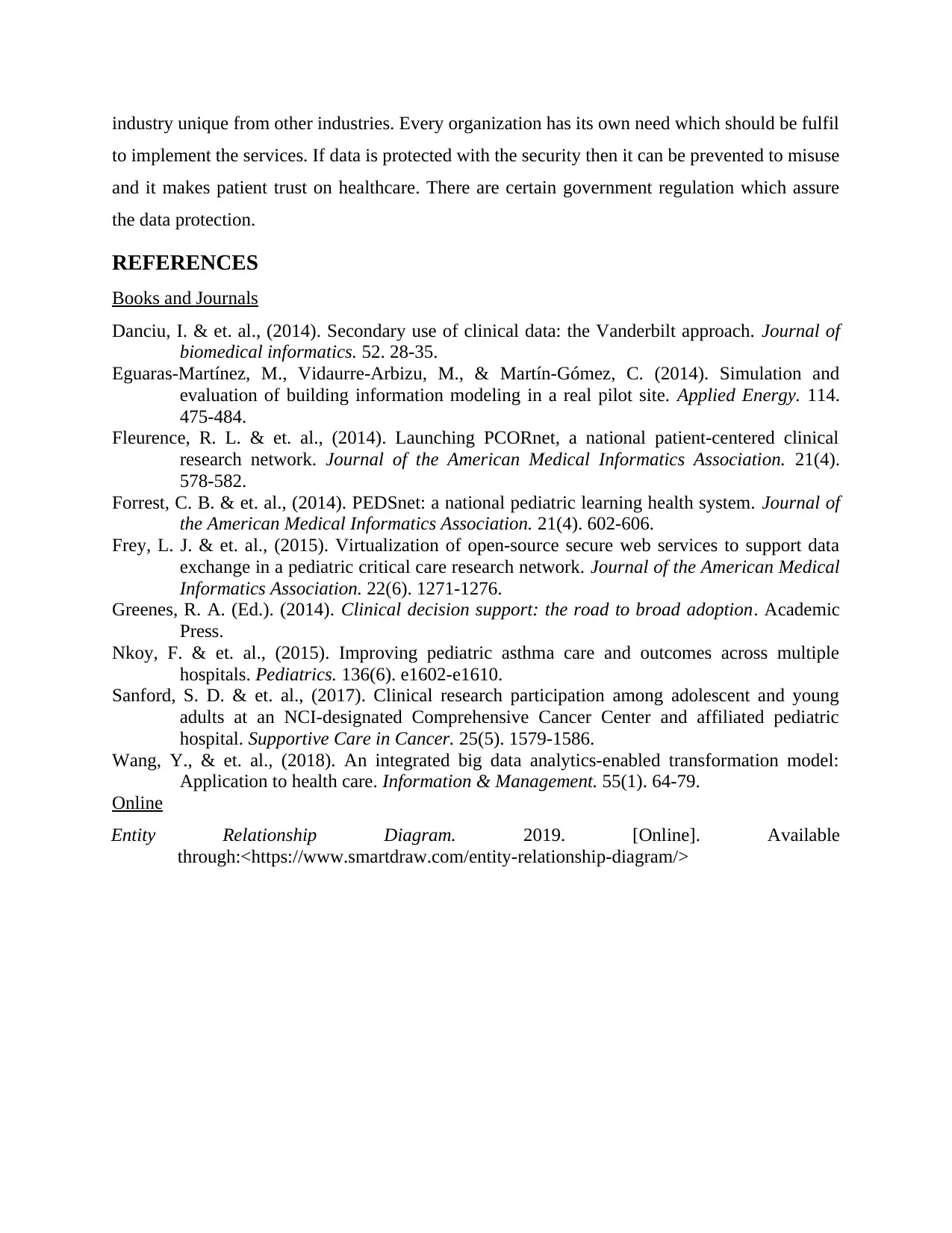
industry unique from other industries. Every organization has its own need which should be fulfil
to implement the services. If data is protected with the security then it can be prevented to misuse
and it makes patient trust on healthcare. There are certain government regulation which assure
the data protection.
REFERENCES
Books and Journals
Danciu, I. & et. al., (2014). Secondary use of clinical data: the Vanderbilt approach. Journal of
biomedical informatics. 52. 28-35.
Eguaras-Martínez, M., Vidaurre-Arbizu, M., & Martín-Gómez, C. (2014). Simulation and
evaluation of building information modeling in a real pilot site. Applied Energy. 114.
475-484.
Fleurence, R. L. & et. al., (2014). Launching PCORnet, a national patient-centered clinical
research network. Journal of the American Medical Informatics Association. 21(4).
578-582.
Forrest, C. B. & et. al., (2014). PEDSnet: a national pediatric learning health system. Journal of
the American Medical Informatics Association. 21(4). 602-606.
Frey, L. J. & et. al., (2015). Virtualization of open-source secure web services to support data
exchange in a pediatric critical care research network. Journal of the American Medical
Informatics Association. 22(6). 1271-1276.
Greenes, R. A. (Ed.). (2014). Clinical decision support: the road to broad adoption. Academic
Press.
Nkoy, F. & et. al., (2015). Improving pediatric asthma care and outcomes across multiple
hospitals. Pediatrics. 136(6). e1602-e1610.
Sanford, S. D. & et. al., (2017). Clinical research participation among adolescent and young
adults at an NCI-designated Comprehensive Cancer Center and affiliated pediatric
hospital. Supportive Care in Cancer. 25(5). 1579-1586.
Wang, Y., & et. al., (2018). An integrated big data analytics-enabled transformation model:
Application to health care. Information & Management. 55(1). 64-79.
Online
Entity Relationship Diagram. 2019. [Online]. Available
through:<https://www.smartdraw.com/entity-relationship-diagram/>
to implement the services. If data is protected with the security then it can be prevented to misuse
and it makes patient trust on healthcare. There are certain government regulation which assure
the data protection.
REFERENCES
Books and Journals
Danciu, I. & et. al., (2014). Secondary use of clinical data: the Vanderbilt approach. Journal of
biomedical informatics. 52. 28-35.
Eguaras-Martínez, M., Vidaurre-Arbizu, M., & Martín-Gómez, C. (2014). Simulation and
evaluation of building information modeling in a real pilot site. Applied Energy. 114.
475-484.
Fleurence, R. L. & et. al., (2014). Launching PCORnet, a national patient-centered clinical
research network. Journal of the American Medical Informatics Association. 21(4).
578-582.
Forrest, C. B. & et. al., (2014). PEDSnet: a national pediatric learning health system. Journal of
the American Medical Informatics Association. 21(4). 602-606.
Frey, L. J. & et. al., (2015). Virtualization of open-source secure web services to support data
exchange in a pediatric critical care research network. Journal of the American Medical
Informatics Association. 22(6). 1271-1276.
Greenes, R. A. (Ed.). (2014). Clinical decision support: the road to broad adoption. Academic
Press.
Nkoy, F. & et. al., (2015). Improving pediatric asthma care and outcomes across multiple
hospitals. Pediatrics. 136(6). e1602-e1610.
Sanford, S. D. & et. al., (2017). Clinical research participation among adolescent and young
adults at an NCI-designated Comprehensive Cancer Center and affiliated pediatric
hospital. Supportive Care in Cancer. 25(5). 1579-1586.
Wang, Y., & et. al., (2018). An integrated big data analytics-enabled transformation model:
Application to health care. Information & Management. 55(1). 64-79.
Online
Entity Relationship Diagram. 2019. [Online]. Available
through:<https://www.smartdraw.com/entity-relationship-diagram/>
⊘ This is a preview!⊘
Do you want full access?
Subscribe today to unlock all pages.

Trusted by 1+ million students worldwide
1 out of 9
Your All-in-One AI-Powered Toolkit for Academic Success.
+13062052269
info@desklib.com
Available 24*7 on WhatsApp / Email
![[object Object]](/_next/static/media/star-bottom.7253800d.svg)
Unlock your academic potential
Copyright © 2020–2025 A2Z Services. All Rights Reserved. Developed and managed by ZUCOL.
